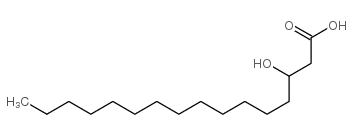3-Hydroxyhexadecanoic Acid

3-Hydroxyhexadecanoic Acid structure
|
Common Name | 3-Hydroxyhexadecanoic Acid | ||
|---|---|---|---|---|
| CAS Number | 928-17-6 | Molecular Weight | 272.42300 | |
| Density | 0.955g/cm3 | Boiling Point | 405ºC at 760 mmHg | |
| Molecular Formula | C16H32O3 | Melting Point | N/A | |
| MSDS | USA | Flash Point | 212.9ºC | |
|
Determination of monomeric composition in polyhydroxyalkanoates by liquid chromatography coupled with on-line mass spectrometry and off-line nuclear magnetic resonance.
Talanta 146 , 107-13, (2015) Polyhydroxyalkanoates (PHAs) are commercially-valuable biocompatible and biodegradable polymers with many potential medical, pharmaceutical and other industrial applications. The analysis of PHA monomeric composition is especially challenging due to the broad... |
|
|
Characterization of bacteria degrading 3-hydroxy palmitic acid methyl ester (3OH-PAME), a quorum sensing molecule of Ralstonia solanacearum.
Lett. Appl. Microbiol. 60(5) , 447-55, (2015) Bacterial wilt pathogen Ralstonia solanacearum causes severe crop loss of eggplant, which is of economic importance in India. 3-hydroxy palmitic acid methyl ester (3OH-PAME) is the main quorum sensing molecule governing the expression of virulence factors in ... |
|
|
Mitochondrial bioenergetics deregulation caused by long-chain 3-hydroxy fatty acids accumulating in LCHAD and MTP deficiencies in rat brain: a possible role of mPTP opening as a pathomechanism in these disorders?
Biochim. Biophys. Acta 1842(9) , 1658-67, (2014) Long-chain 3-hydroxylated fatty acids (LCHFA) accumulate in long-chain 3-hydroxy-acyl-CoA dehydrogenase (LCHAD) and mitochondrial trifunctional protein (MTP) deficiencies. Affected patients usually present severe neonatal symptoms involving cardiac and hepati... |
|
|
Long-chain 3-hydroxy fatty acids accumulating in LCHAD and MTP deficiencies induce oxidative stress in rat brain
Neurochem. Int. 56 , 930-936, (2010) Accumulation of long-chain 3-hydroxy fatty acids is the biochemical hallmark of long-chain 3-hydroxyacyl-CoA dehydrogenase (LCHAD) and mitochondrial trifunctional protein (MTP) deficiencies. These disorders are clinically characterized by neurological symptom... |
|
|
Burkholderia mallei expresses a unique lipopolysaccharide mixture that is a potent activator of human Toll-like receptor 4 complexes.
Mol. Microbiol. 63 , 379-390, (2007) Burkholderia mallei, the aetiologic agent of glanders, causes a variety of illnesses in animals and humans ranging from occult infections to acute fulminating septicaemias. To better understand the role of lipopolysaccharide (LPS) in the pathogenesis of these... |
|
|
Structural features of lipid A of Piscirickettsia salmonis, the etiological agent of the salmonid rickettsial septicemia.
Acta Virol. 51 , 249-259, (2007) The composition and structure of lipid A isolated from the lipopolysaccharide (LPS) of Piscirickettsia salmonis were investigated by chemical analyses, gas chromatography/mass spectrometry (GCMS), and electrospray ionization (ESI) combined with the tandem mas... |
|
|
Structural features of lipid A of Rickettsia typhi.
Acta Virol. 55 , 31-44, (2011) Lipid A isolated from the Rickettsia typhi lipopolysaccharide (LPS) was investigated for its composition and structure using chemical analyses, gas chromatography-mass spectrometry (GC-MS), and electrospray ionization (ESI) combined with the tandem mass spect... |
|
|
Hypoxia reduces the efficiency of elisidepsin by inhibiting hydroxylation and altering the structure of lipid rafts.
Mar. Drugs 11 , 4858-75, (2013) The mechanism of action of elisidepsin (PM02734, Irvalec®) is assumed to involve membrane permeabilization via attacking lipid rafts and hydroxylated lipids. Here we investigate the role of hypoxia in the mechanism of action of elisidepsin. Culturing under hy... |
|
|
Identification of 3-hydroxypalmitic acid methyl ester as a novel autoregulator controlling virulence in Ralstonia solanacearum.
Mol. Microbiol. 26(2) , 251-9, (1997) Expression of virulence genes in Ralstonia solanacearum, a phytopathogenic bacterium, is controlled by a complex regulatory network that integrates multiple signal inputs. Production of several virulence determinants is coordinately reduced by inactivation of... |
|
|
Analysis of isomeric long-chain hydroxy fatty acids by tandem mass spectrometry: application to the diagnosis of long-chain 3-hydroxyacyl CoA dehydrogenase deficiency.
Rapid Commun. Mass Spectrom. 17(2) , 171-5, (2003) Acetyl trimethylaminoethyl ester iodide derivatives have been used to selectively analyze isomeric long-chain hydroxy fatty acids by electrospray ionization tandem mass spectrometry (ESI-MS/MS). The binary derivatives of 2-, 3-, 12- and 16-hydroxypalmitic aci... |